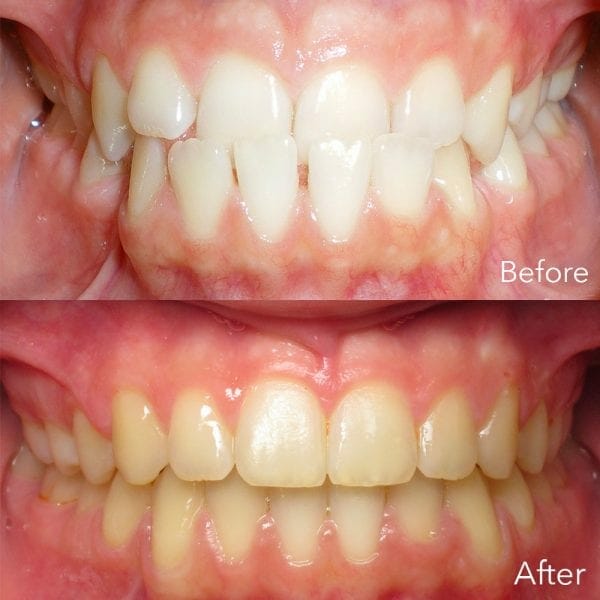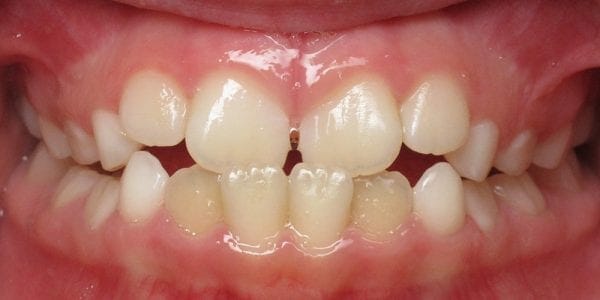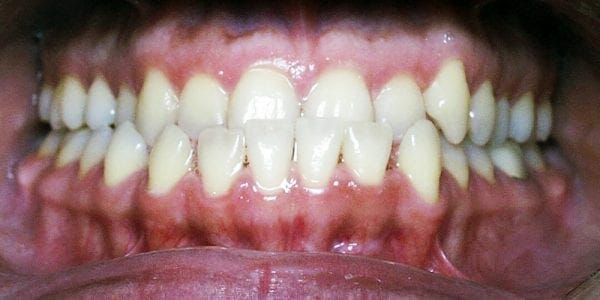What is a Crossbite?
A crossbite is a type of malocclusion (a fancy term that means the bite is out of alignment). Also known as a “bad bite” or “poor bite,” malocclusions are one of the problems that orthodontists like Dr. Redford and Dr. Burke receive special training to correct.
A crossbite is a bite problem that occurs when the top and bottom teeth do not come together properly. There are two types of crossbites:
- Anterior crossbite: Upper front teeth set behind the lower front teeth
- Posterior crossbite: Upper back teeth set inside the lower back teeth
An anterior crossbite is often referred to as an underbite. The term anterior crossbite can be used to describe one or more teeth in the poor bite relationship, whereas the term underbite usually refers to when all the front teeth are affected.
Crossbites are quite common. The prevalence of posterior crossbite in children is estimated to be between 1% and 16% of children with their baby teeth. The rate of anterior crossbites is between 4% and 5%.

What Causes a Crossbite in Children?
Crossbites typically develop during childhood and can be caused by several different things. In many cases, crossbites have a genetic component, which means they can be inherited. If a parent has a crossbite, then chances increase that their children may have one as well.
In addition to genetics, crossbites could also be caused by:
- Delay in losing baby teeth
- Abnormal eruptions of teeth
- Excessive finger or thumb sucking
Preventing Crossbites in Children
Although not all crossbites can be prevented (especially those with genetic, dental, or skeletal causes), crossbites caused by oral habits such as thumb sucking can be treated with an orthodontic device called a habit appliance.
A habit appliance is a device that helps prevent children from sucking on their fingers or thumbs. It does this by interrupting the behavior and is successful about 90% of the time.
In addition to the use of a habit appliance, parents can also work with their children to stop the habit using a variety of home remedies such as:
- Positive reinforcement
- Replacing the habit with a less damaging one
- Books and videos that discuss the problems caused by thumb sucking
- Bad-tasting nail polish
- Thumb or finger covers

What Issues Can Crossbites in Children Cause?
It is important to treat a crossbite early to prevent additional problems later. Because children’s jaws are still developing and growing, it is best to correct a crossbite when children are between the ages of 7 and 12.
After the age of 12, it can be difficult to get the results that are possible in younger children. This is because the growth plate that runs front-to-back down the palate (upper jaw) in children is not fully fused—allowing it to be expanded easily and comfortably with orthodontic devices. If left untreated, crossbites in older teens and adults might only be corrected with jaw surgery.
If a crossbite in children is left untreated, it can lead to a variety of problems, including:
- Premature enamel wear
- Difficulty speaking and/or chewing
- Facial asymmetry
- Uneven jaw growth
How to Fix a Crossbite in Children
Fortunately, there are several options for crossbite correction in children. In most cases, Dr. Redford and Dr. Burke will use a combination of orthodontic appliances—including palatal expanders, metal braces, clear aligners, or retainers—to correct the crossbite.
Treatment for anterior crossbite correction in children depends on the root cause of the problem. If it is a jaw position problem, correction is accomplished by using an appliance that attaches to an upper expander device that pulls the upper jaw forward. This usually takes 6-12 months. If the problem is caused by improper tooth position, then braces, aligners, or retainers may be used to move the teeth. It is important to note that braces will only move teeth, not jaws, so their use will have limitations if the anterior crossbite is caused by a jaw size mismatch.
For posterior crossbites, treatment again depends on the cause of the problem. If the upper jaw is narrow relative to the lower jaw (the case in most instances of posterior crossbite), a palatal expander is used to increase the width of the upper jaw. A palatal expander is an orthodontic device that widens the roof of a patient’s mouth. Although this may sound frightening, palatal expanders are proven orthodontic devices that use slow and gentle pressure and provide excellent results. While they take 1-2 weeks to become accustomed to, they typically cause less soreness than actual braces do. Once the jaw has been widened, the results are permanent.
There are some orthodontists who claim that expanders are not needed or useful because braces can accomplish the same goals. This is misleading, however, as braces can only “tip” teeth to correct crossbites, not widen the jaws themselves.
As mentioned earlier, the jaw can be widened in children because the jaw is still developing and growing. This type of device is most effective when used in children between the ages of 7 and 12.
There are two types of palatal expanders—a banded expander and a bonded expander. Each type is custom-made for the patient. The type of device to be used will depend on the patient’s unique situation. The difference between these two types of expanders is described below.
- Bonded Expander. This type of palatal expander is primarily used on younger patients who have a mix of baby and adult teeth. It can sometimes be used on teen patients. An acrylic bite block is molded to fit over several back teeth. These blocks are bonded to the teeth with orthodontic adhesive. A metal expansion mechanism is attached to the bite blocks and sits in the middle of the palate. This type of expander is often used when an anterior crossbite is present because it helps to “unlock” the front bite relationship to “jump” the anterior crossbite.
- Banded Expander. This type of palatal expander uses stainless steel rings (called bands) to go around the first molars. As with the bonded expander, a metal expansion mechanism sits in the middle of the palate.
To widen the jaw, a “key” is inserted into a center screw in the metal expansion mechanism and turned to apply gentle pressure that widens the jaw over time. Each patient will get a customized “activation schedule” for how often to activate the appliance. Typically, patients complete one turn of the key every night for one to six weeks. (The time will depend on how much expansion is needed). Each turn of the key is one quarter of a millimeter. So, as mentioned above, expansion should not cause any pain.
Once activation is complete, the appliance remains in place for several months for the expansion to “set.” Although this may sound difficult or confusing, Dr. Burke and Dr. Redford will provide detailed training and instruction for using the device. A parent’s help will be most likely be needed with younger patients.


If needed, the doctors may also use braces or aligners to help correct crossbites in children. The exact treatment method will depend on the cause of the crossbite and other orthodontic issues that may be present.
Frequently Asked Questions About a Child’s Crossbite
How can I tell if my child has a crossbite?
A crossbite happens when one or more of the upper teeth sit inside the lower teeth instead of slightly outside them when the kid bites down. This can involve the front teeth, the back teeth, or both. Parents often notice that a child’s smile looks “off center” or that the upper teeth seem to close on the inside of the lower teeth.
At Burke & Redford Orthodontists, Dr. Ryan Redford and Dr. Michael Burke carefully check how a child or teen brings their teeth together from several angles, often using photos and digital X‑rays, to confirm whether a crossbite is present and whether it affects a single tooth or a group of teeth.
Is a crossbite in kids serious, or will my child grow out of it?
Most children do not simply “grow out of” a true crossbite. If a crossbite is left untreated, it can lead to uneven tooth wear, gum irritation, jaw joint problems, difficulty chewing, and even facial asymmetry as the jaw grows.
Dr. Ryan Redford and Dr. Michael Burke explain to parents that early crossbite treatment in a kid or teenager is usually simpler and more predictable than waiting until jaw growth is complete. At Burke & Redford Orthodontists, the doctors design a plan that aims to protect long‑term oral health as well as the child’s appearance and self‑confidence.
What causes a crossbite in children and teens?
Crossbites in children and teens can be caused by a combination of genetics and environmental factors. A child may inherit a narrow upper jaw, a wide lower jaw, or tooth size and shape that make alignment difficult. Other causes include delayed loss of baby teeth, abnormal eruption of permanent teeth, and long‑term thumb sucking or pacifier use that can change the way the jaws grow.
At Burke & Redford Orthodontists, Dr. Ryan Redford and Dr. Michael Burke look at each kid’s growth pattern, family history, oral habits, and tooth eruption sequence so they can identify the specific reasons for the crossbite and target those causes in the treatment plan.
What is the best age to treat a crossbite in a child?
The ideal time to evaluate a child for a possible crossbite is usually around age 7, when the first permanent molars and some permanent front teeth are present. At this age, the upper jaw is still growing and the mid‑palatal growth plate has not fully fused, which allows orthodontists to widen the jaw more easily with gentle appliances.
Dr. Ryan Redford and Dr. Michael Burke often recommend beginning crossbite treatment for children between ages 7 and 12, while there is still good growth potential. Teens can still be treated successfully, but some options may be more limited once growth slows, which is why Burke & Redford Orthodontists encourages parents to schedule an early checkup even if the kid does not yet complain about their bite.
What are the main treatment options for crossbite in kids and teenagers?
The most common treatments for crossbite in children and teens include:
-
Palatal expanders to gently widen a narrow upper jaw
-
Braces to align the teeth and fine‑tune the bite
-
Clear aligners in selected cases where the crossbite is mild to moderate
-
Habit appliances to help stop thumb sucking or other habits that contribute to the bite problem
These options are often combined in phases, starting with jaw expansion followed by braces or aligners to complete the correction.
At Burke & Redford Orthodontists, Dr. Ryan Redford and Dr. Michael Burke customize treatment for each child or teenager, choosing the appliances that will correct the crossbite efficiently while keeping day‑to‑day life as comfortable as possible.
Can braces or clear aligners fix a crossbite in a teen?
Yes, braces can correct many crossbites in teens by gradually moving the teeth into a healthier position. In some cases, especially when the upper jaw is narrow, a palatal expander is used first, followed by braces to complete the correction. Clear aligners can also help fix certain crossbites, particularly mild to moderate dental crossbites where the jaw size is acceptable and only tooth position needs to be adjusted.
Dr. Ryan Redford and Dr. Michael Burke evaluate each teen or older child individually at Burke & Redford Orthodontists to decide whether braces, aligners, or a combination will give the best long‑term result.
How long does crossbite treatment usually take for children and teens?
Treatment time depends on the type and severity of the crossbite, the child’s age, and whether jaw correction or only tooth movement is needed. Palatal expansion often takes a few weeks to a few months, followed by a stabilization period. Comprehensive treatment that includes braces or clear aligners typically ranges from about 12 to 24 months for many children and teenagers.
At Burke & Redford Orthodontists, Dr. Ryan Redford and Dr. Michael Burke explain the expected timeline at the start and review progress at every visit so parents and kids know how treatment is advancing and what steps remain.
Is crossbite treatment painful for kids, and how can parents help?
Most kids feel some pressure or mild soreness when a new appliance such as a palatal expander or braces is placed or adjusted. This is usually temporary and can often be managed with soft foods, over‑the‑counter pain relief, and careful brushing while the child or teen gets used to the appliance.
Dr. Ryan Redford and Dr. Michael Burke take time to show children and teenagers exactly what to expect during crossbite treatment at Burke & Redford Orthodontists. They also give parents practical instructions on oral hygiene, diet, and appliance care so that discomfort is minimized and the kid’s smile stays healthy throughout treatment.
To schedule a consultation, contact Burke & Redford Orthodontists in Lake Elsinore or Temecula by calling our main office at (951) 699-8011 or fill out the free orthodontic consultation form on our website.